Lighthouses at Dungeness
![]() Introduction
Introduction
![]() First Lighthouse August 1615 open coal-fired 35ft high
First Lighthouse August 1615 open coal-fired 35ft high
![]() Second Lighthouse October 1635 coal-fired 110ft high
Second Lighthouse October 1635 coal-fired 110ft high
![]() Third Lighthouse 1792 oil lamps, then electricity (1862), finally paraffin 116 ft high
Third Lighthouse 1792 oil lamps, then electricity (1862), finally paraffin 116 ft high
![]() Fourth Lighthouse March 1904 paraffin lamp 136 ft high
Fourth Lighthouse March 1904 paraffin lamp 136 ft high
![]() Fifth Lighthouse November 1961 electricity 141ft high automatic operation
Fifth Lighthouse November 1961 electricity 141ft high automatic operation
![]() Low Lighthouses
Low Lighthouses
![]() Daboll's Fog-Trumpet
Daboll's Fog-Trumpet

Dungeness lies at the southernmost point of Kent and is an enormous flat of sand and shingle which has been a hazard to shipping for hundreds of years. Dungeness Lighthouse marks the end of the peninsula and is also an important way mark and reference for vessels navigating the Dover Straits.
![]() Location Map
Location Map
There have been seven lighthouses at Dungeness since the early 1600s, five high and two low, with the fifth high one still fully operational today.
By the 1600’s Dungeness was a huge foreland of shingle, extensive enough to cause numerous shipwrecks, with much loss of life and cargo. The movement and build of the shingle around Dungeness has meant the sea has retreated over the hundreds of years, with successive lighthouse ending up too far from the sea. more...
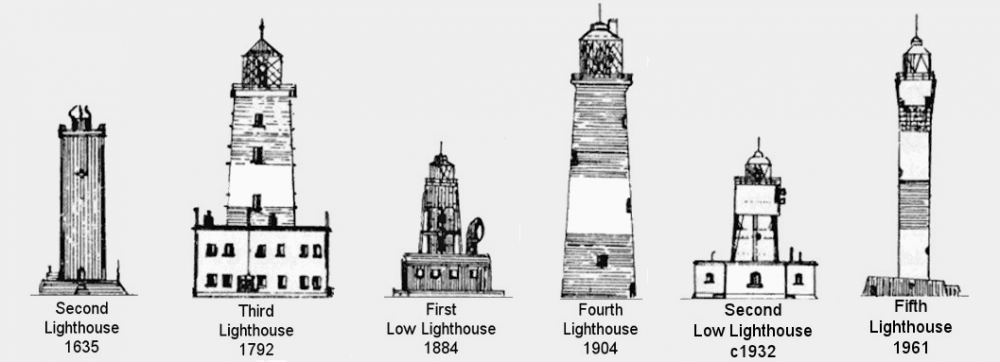
Six of the seven Lighthouses
A lighthouse at Dungeness was first mentioned around 1600 when Trinity House reported against a proposal for a light at Dungeness Point. Trinity House subsequently withdrew its opposition and an open coal fire was erected, with tolls of one penny per ton being levied from all ships passing it during the next 40 years.
The first lighthouse was erected in August 1615. It was a wooden tower 35 feet high and had a coal brazier at the top, the fuel being hauled up by a basket and pulley. Candles eventually replaced the coal fire, doubtless from the difficulty in transporting coal to such an out-of-the-way spot.
Time, though, had taken its toll and, as the sea receded further, seamen complained of the distance of the lighthouse from the water's edge, so in 1635 the existing tower was pulled down and a more substantial brick built tower, 110 foot higher, was built with a coal fire, nearer to Dungeness Point.
In the picture on the right, the lighthouse keeper can be seen tending the coal fire in a huge fire basket at the top, whilst opposite him there hangs a basket full of coal from an iron jib and pulley. Around the base of the tower there is a single story building which was the keepers' living accommodation.
The quality of the light once again came under review and in 1668 Trinity House insisted that better illumination must be provided. A coal fire continued to light Dungeness in 1746, but the position of the lighthouse was complained of as being misleading as the sea had again receded, leaving the tower far from the water's edge.
This second lighthouse lasted over 100 years, but as it too became victim of the increasing shingle banks and after more complaints about poor light visibility at sea, a new third Lighthouse was demanded by Trinity House
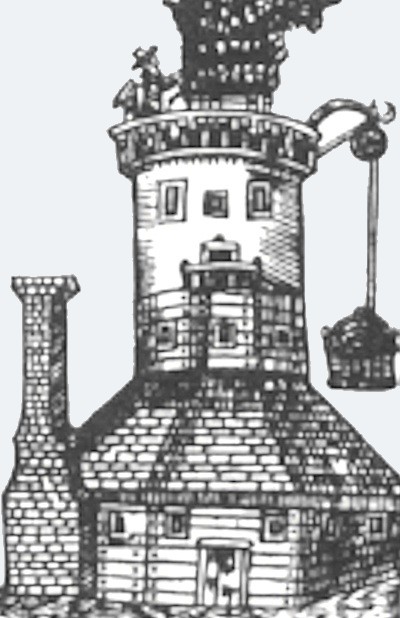
Wood Engraving of the 1635 Lighthouse
In 1792 Samuel Wyatt, consultant engineer to Trinity House, built a tower about 115 feet high (35 metres), of the same design as Smeaton's lighthouse on Eddystone, which lasted for over 100 years.
Eighteen oil lamps, first using sperm (whale) oil and later vegetable oil, took the place of the coal fire. In 1818, it had parabolic reflectors in use.
By 1818 the foundations were threatened by decomposition, as the mortar had been mixed with seawater. Strong buttresses had to be erected round the base, and after a violent storm in 1821 other repairs had to be made to strengthen the tower.
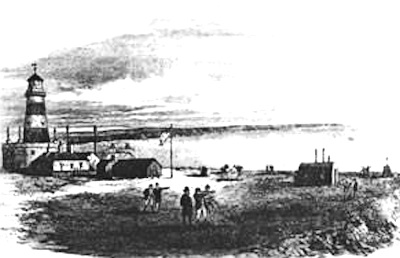
Wyatt's Lighthouse in 1792
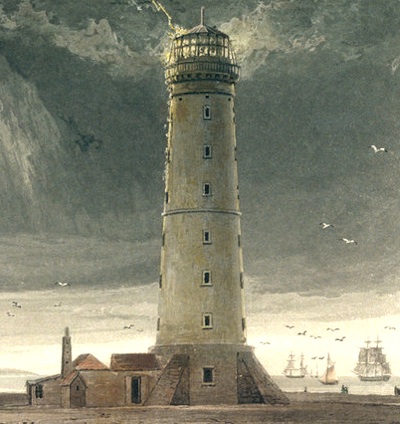
Wyatt's Lighthouse in 1822; picture by Daniell
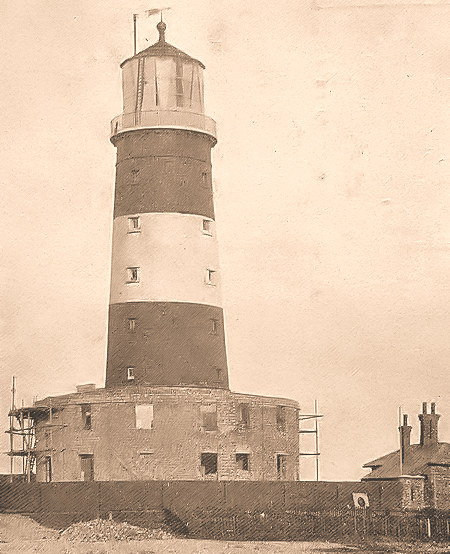
Wyatt's Lighthouse c1900
In 1862, Dungeness lighthouse became one of the first lighthouses to be illuminated by electric light. However this form of power was superseded by a more efficient means, given the technology available at that time, a huge oil lamp of 850 candle power surrounded by glass prisms which increased the illuminating power by a hundredfold. At this time the outer wall of the tower was painted black with a white band to render it more conspicuous in daylight.
Quarters for the lighthouse keepers were built in a circular form around the base of Wyatt’s tower. Although the tower was taken down in 1904 these quarters are still in existence today. (see pictures)
Article in Harpers Weekly 1864
We give on this page an engraving of Dungeness Light-house (pictured right), in the British Channel, where The English Government has recently, stationed the Fog_ Trumpet indented by Mr. C. L. Daboll, of New London, Connecticut, and which is destined to produce a complete revolution in fog-signals for light-house purposes.
An experiment on the trumpet, in connection with a bell and steam-horn previously put there, was made by the Trinity House Committee of London, on board their steam-yacht, on the 17th of November last, commencing at noon. The trumpet, bell, and horn were each tried in succession for three minutes ; then they were all sounded together for the same period of time, and afterward made continuous until 2 P.M., when the bell and horn ceased, and the fog-trumpet continued to give its signals at intervals of ten seconds, with five seconds length of blast, until 3 P.M., when the trial ceased, and the yacht then steamed away for Dover.
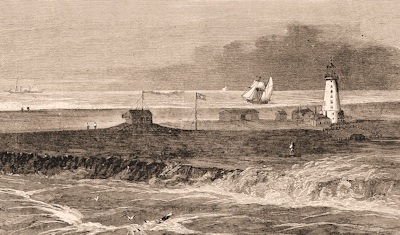
Lighthouse in 1864 showing Daboll's Fog-Trumpet (see text)
There was a strong wind at the time of the trial, with frequent squalls of rain, and a heavy surf on the beach, but the result was so satisfactory to the Committee that the English Government purchased the apparatus of Mr. Daboll, and have made it a permanent signal at Dungeness Light-house. It is placed in the smaller building, as shown in the illustration.
Towards the end of the 19th Century the shingle bank had increased to such an extent that an additional smaller Low Light became necessary and was placed near the waters edge.
A low lighthouse was needed because of the continous build up of shingle between the beach and the high lighthouse caused difficulties for ships passing Dungeness Point, with some going aground.
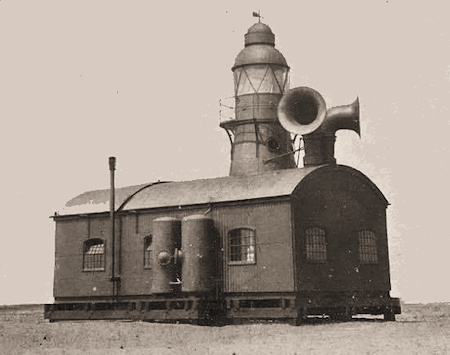
First Low Lighthouse with associated foghorn c1900
The first low lighthouse was built in 1884. Constructed of metal built on a wooden base, a siren-type foghorn was housed in the same building. The low lighthouse could be seen from about 10 miles, compared to about 17 miles for the high lighthouses.
By c1932 this first low lighthouse was in need of repair and it was decided to replace it.
The new low lighthouse, together with its associated foghorn, lasted until 1959 when it was demolished to make way for the current high lighthouse.
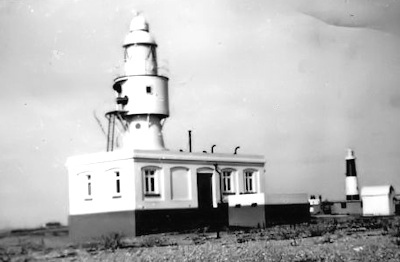
Second Low Lighthouse c1950
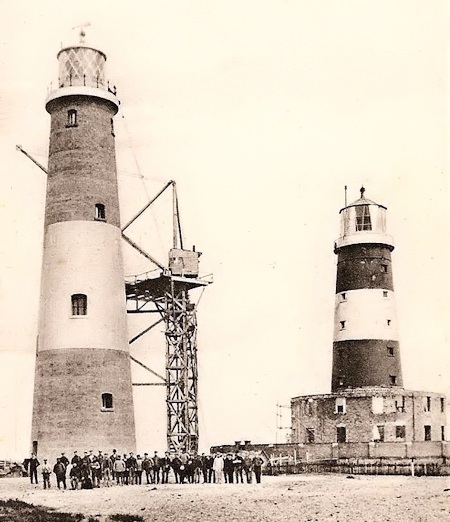
Lighthouses 3 (Wyatt's right) and 4 in 1904 (Ack. 3)
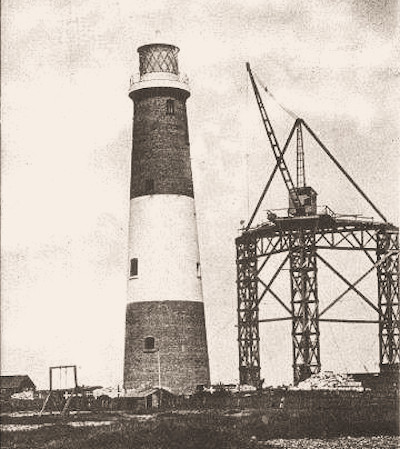
Lighthouse No. 4 in completed in1904
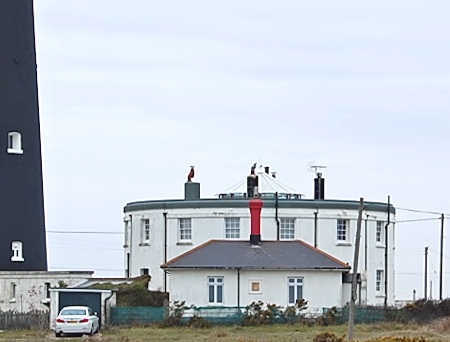
Base of the 1792 Lighthouse, next to the 1904 Lighthouse
By the turn of the nineteenth century, it was apparent that due to the recession of the sea a new lighthouse was needed. In 1901, Messrs. Pattrick & Co. of London, began to build a new lighthouse 50 yards from the base of the 1792 tower.
This circular brick structure, then known as the High Light Tower, was 150ft or 43 metres high and 11 metres in diameter at ground level, was completed early in 1904, and was first lighted on the 31st March in that year.
The tower was painted externally in black and white bands so that it formed a beacon recognisable by mariners during daylight. Although no longer owned by Trinity House, this tower still remains at Dungeness but painted black to avoid it being confused with the 1961 lighthouse.
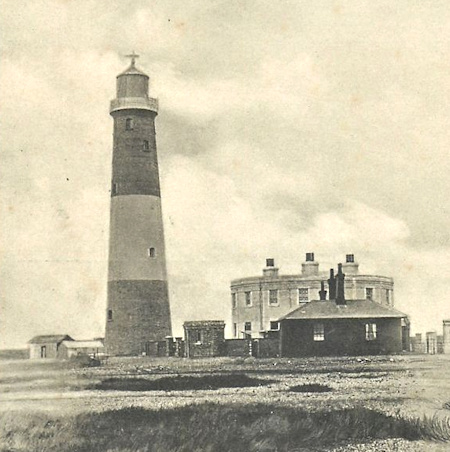
The 1904 Lighthouse, The Old Lighthouse c1900
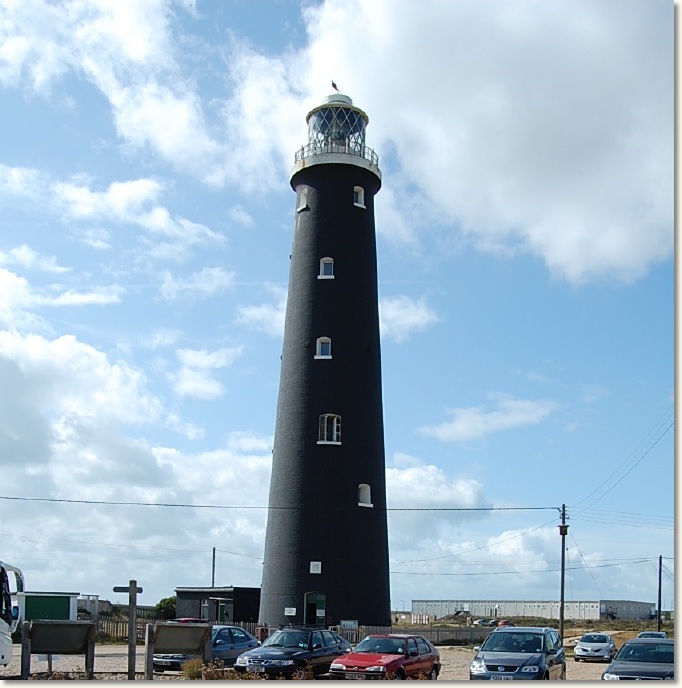
The 1904 Lighthouse, The Old Lighthouse today
The 1904 lighthouse stands more than 540 yards (500 metres) from High Water Mark. Its navigational light was obscured by the nuclear Power Station erected approximately a quarter of a mile to the west of the lighthouse.
This lighthouse still stands today and is open to the public. For more information, please see The Old Lighthouse.
When the power station was built in the 1960s the 1904 lighthouse was no longer visible from the south west. With the light being obscured by the power station, it was neccessay to place another light in a cylindrical tower some 500 yards (450 metres) to the east. It also incorporated an electric fog signal. The new lighthouse was brought into operation on 20 November 1961.
The tower which rises from a white concrete base in the form of a spiral ramp, is capable of automatic operation and was the first one of its kind to incorporate the Xenon electric arc lamp as a source of illumination.
It is constructed of precast concrete rings 1.5 metres high, 15 cm thick and 3.6 metres in diameter, fitted one above the other to a height of 40 metres (130ft), and has black and white bands which are impregnated into the concrete.
The station was re-engineered/modernised in 2000. The sealed beam light was replaced with a Pharos PRB20 optic transferred from Lundy South Lighthouse, reducing the light range from 27 to 21 nautical miles.
Dungeness Lighthouse was converted to automatic operation in 1991 and is monitored and controlled from the Trinity House Operations and Planning Centre at Harwich.
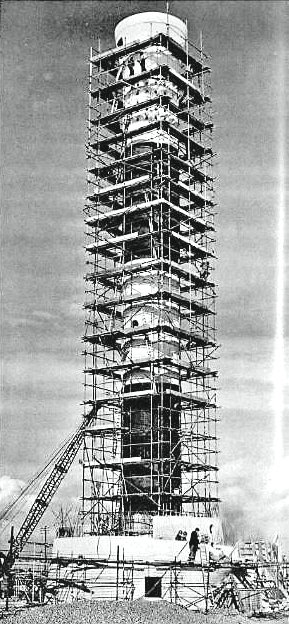
Fifth Lighthouse being built in 1960
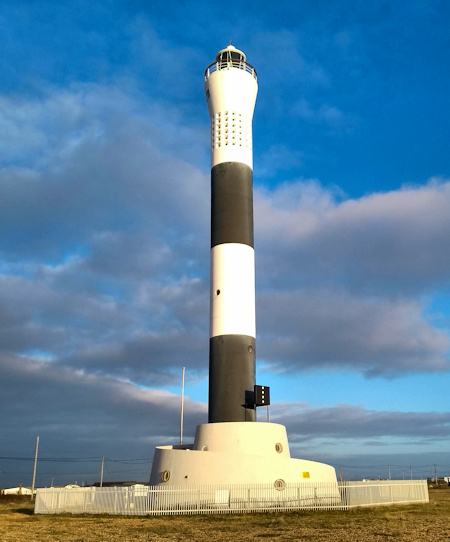
Fifth Lighthouse in 2019



